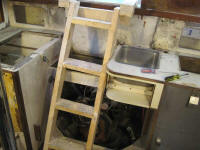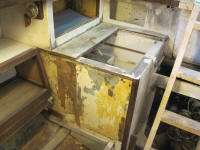
110 Cookson Lane | Whitefield, ME 04353 | 207-232-7600 | tim@lackeysailing.com
I took a break from the deck work and worked in the cabin instead, though originally that'd not been my intention.
I started in the morning by crawling beneath the poop deck to remove the plastic-covered plywood panels I'd temporarily installed to support the deck and fill the large hatch holes during the recore. With those out of the way, I turned my attention to the cockpit, where I enlarged many of the existing old fastener holes and the like to prepare them for patching and filling, as I'd expected to start the filling, fairing, and patching process in the cockpit well, the last major area of the decks requiring this treatment.
During this process, I noticed several exposed screw heads at the leading edge of the cockpit well. It appeared they were holding in parts of the galley countertop and other structure, which I knew I'd be removing soon, as the galley was one of two portions of the interior--the other being the head--slated for rebuilding during this project.
Those little screw heads forced my hand, and I decided to focus on the galley removal instead of proceeding with the deck work for the moment.
During most of the remainder of the day, I removed the old galley, engine enclosure, and icebox. The reasons for this, which the owner and I had discussed at some length in preceding weeks, were several. First, the icebox side of the galley was badly water-damaged, with significant delamination on the countertop, and evidence of additional water damage in other portions of the cabinet. Second, the port side of the galley also contained significant water damage, most notably in the lockers beneath the countertop between the sink and stove; in addition, the countertop was old and damaged cosmetically, and it had been clear from the getgo that there would be at least some rebuilding or reconfiguration work required.
Finally, the engine access left something to be desired, and the owner had expressed interest in improving engine access for ease of maintenance and inspection.
The main cabin forward of the galley was generally in acceptable condition, other than cosmetics and a few minor repairs, so we decided to dismantle the boat only as far forward as the aft end of the settees on each side. On the port side, there was a partial bulkhead here, making a natural ending point; to starboard, the icebox also formed the aft edge of the settee, but would still provide a logical stopping point.
The old galley was constructed of several different and random types of plywood and a variety of hardwood cleats, most of which were secured with screws from the back side of whatever bulkhead or structural member to which they were attached. It's always a fun and instructive exercise to dismantle an older construction; documentation provided by the owner suggested that the interior I was now dismantling--along with the cabin trunk on which I'd already done work--had been constructed over a period of time between 1980 and 1983.
Overall, the port side of the galley came out with relative ease and no collateral damage. The partial bulkhead at the forward end remained in place, and would eventually form the building block for the new galley, to be constructed a bit later in the process.

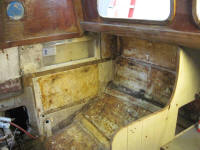
The icebox, as per usual, was far more interesting in its construction. The smell of mold was ripe as I began to cut it apart; I had to cut the forward side of the box several inches away from the starboard settee cabinetry in order to avoid unwanted collateral damage to the settee during the demolition. The badly delaminated countertop came right off first, though, each lamination of the plywood completely separate from the other layers.
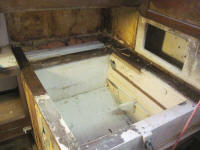
Once I'd cut enough of the icebox's front side, I could pretty easily remove the remainder of the box itself in a couple large pieces. The box contained two different kinds of foam--white styrofoam and 1" blueboard--and had been originally constructed in situ of plywood covered with a layer of fiberglass on the inside. The bottom layer of plywood was completely delaminated as well.
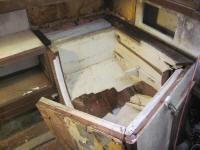

Beneath the box, and around the sides, had been stuffed regular fiberglass house insulation, which filled large cavities on all sides of the box, and was damp and in poor condition. This was a surprising choice of the original builder, and it had not been a good choice. Dampness in the fiberglass insulation, which was right against the hull, had almost certainly led to the beginnings of the process that ultimately ended in the complete structural failure of the icebox cabinet.
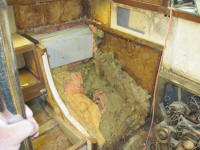
In any event, I cleaned out all the old insulation and remaining bits of the cabinet, and removed the myriad screws poking through the bulkheads and other places. For the moment, I left a small portion of the original plywood front section of the icebox, which was supporting the aft end of the starboard settee and cabinet above. The plywood was delaminated and would have to be replaced, but first I'd need to build some temporary support structure for the adjacent cabinetry, to hold it while I fitted the new bulkhead later in the process.
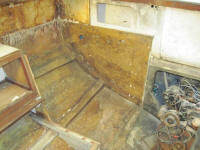
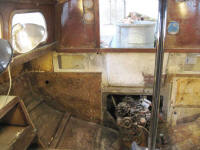
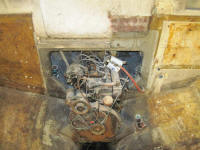
Removing the galley generated two full trashcans of insulation and small bits, and a large pile of wooden debris. It'd probably be a while before I began to rebuild the space--there was much preparatory work to complete first, both outside and inside the boat--but now the empty space formed an appropriate inspiration for what might come next.
I also removed some Formica and thin foam that had been installed against the hull in the space above the starboard settee cabinets.
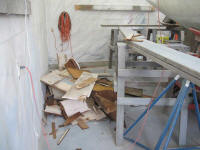


Total Time Billed on This Job Today: 6.75 hours


